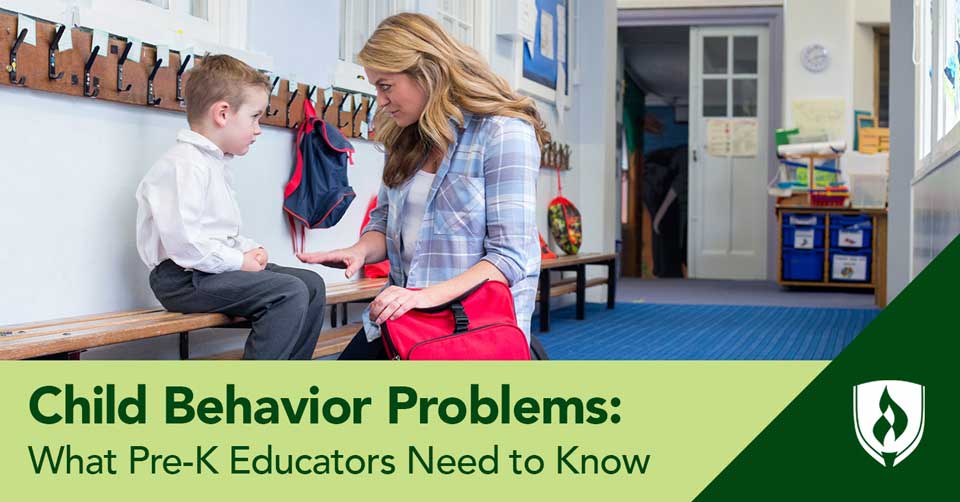
Spend any amount of time with a child, and you’ll realize a few things. One, children are magical. Their ideas and faces are so full of energy and inspiration that they will sometimes take your breath away. Two, children are unpredictable. Sudden bursts of crying, fits of truly volcanic rage, shyness, aggressive physicality, whining, you name it—and it’s only 9:30 in the morning!
You know some of these seemingly chaotic moments are just a natural part of growing up and learning to navigate the world around them. But with behavioral problems in preschool children, it’s natural to wonder if there’s more going on, a better way to handle the situation or other things you should be looking out for.
Preschool teachers often learn how to respond to preschool behavior problems through experience. As the years and classrooms pass, childhood educators get very familiar with the behaviors most kids exhibit at some point or other.
Aside from formal training or years of experience, there are a few things anyone working with (or parenting) preschoolers should understand about their behavior. We asked Joni Kuhn, early childhood education professor at Rasmussen University, to share some important insights into preschool child behavior problems.
What counts as problematic behavior in children?
Before we get into that, it’s worth giving some thought into how we define behavior issues in children. While it’s true “bad” behavior is subjective—just observe drivers during rush hour to get a sense for the range of what is or isn’t acceptable to different people—but there are still ways to categorically document and define behaviors.
One tried-and-true approach in the field of education is using the Achenbach System of Empirically Based Assessment (ASEBA), a commonly used system that “assesses competencies, strengths, adaptive functioning, and behavioral, emotional, and social problems from age 1½ to over 90 years.”1
Part of the ASEBA framework includes a child behavior checklist for evaluating young children, which lists 100 potentially problematic preschool behaviors, like whining, clinging to adults, wandering off, needing items in their proper places, hitting or being cruel to animals. While this may not cover every possible challenging behavior, it does provide a solid reference point.
What to keep in mind when navigating child behavior problems
1. Behavior is communication
“The first thing to understand is that all behavior is communication,” Kuhn says. She explains that when children aren’t able to effectively communicate with words, they find other ways to express their needs and wants.
Kuhn emphasizes the need to remember just how young these kids are. “Remember, they have only been alive for a matter of months. At the preschool age, children don’t yet know how to express themselves verbally, and they don’t know what to do, behaviorally, to improve a particular situation.”
For example, Kuhn says, think of two-year-olds who bite. “They are not biting to ‘be mean’ or to ‘be a brat.’ They don’t have the verbal skills to say, ‘May I please have that toy?’ That’s all.”
Delve into Social Development in Children to explore how children develop crucial social skills at an early age.
2. Sometimes adults are not aware that they are asking too much
“When we see children who have challenging behaviors, it is usually due to an unmet need,” Kuhn says. “Oftentimes, that unmet need is that they are feeling overly controlled in some way.”
She explains that preschool children don’t have the cognitive development to do many of the things adults want or expect them to do, so it naturally leads to behavior issues. If a child is acting out, consider if they’re potentially being overwhelmed by a situation they don’t quite have the tools to navigate, and give them some space.
3. Learning about the stages of development is key
“One main thing that educators should understand about each behavior is how children develop at each age,” Kuhn says. This includes their development in all domains: physical, intellectual, language, emotional and social.
Kuhn offers an example. Say a three-year-old child tells his educator that he flew to the moon yesterday and is adamant he really did it. Kuhn explains that teachers should not scold the child for lying or correct them. The child isn’t intentionally practicing deceit. “He’s in the egocentric stage of development. This means that if he wants something to be true, it is true.”
Educators should respond by buying into the imagination exercise, Kuhn says. For example, try responding with, “Wow! You went to the moon? That’s so fun! What did you see?”
Based on development and age, cognitively, the child cannot differentiate between telling a tall tale or telling the truth. “As an educator, it’s important to understand that.”
4. Find the reason behind the behavior
If adults assume preschool children are being unreasonable, they misunderstand how young brains and bodies work. “The most important thing we can do is to calmly and kindly find the ‘Why?’ behind the behavior,” Kuhn says. “We need to be curious, not accusatory, when children behave in ways we find challenging.”
If a child destroys a toy, for example, educators could say, “Wow, you took that toy apart, and it’s broken now, but you were so interested in finding out how it worked, weren’t you? What did you learn?”
5. Give children space to problem-solve
“A huge realization I had early on was that it is better to allow children to work things out on their own,” Kuhn says, explaining that she used to swoop in if she heard children arguing over something. She would ask them what they were arguing about and then would tell them what to do.
“I learned that it’s better to let go of trying to control things when working with young children,” Kuhn says. “The sky will not fall, and more often than not, great conversations happen that we would otherwise miss.” She explains that allowing children to figure things out, with some support if necessary, gives them the chance to practice essential skills for adulthood—problem-solving, negotiating and critical thinking.
“As adults, we tend to rob children of the time they need to practice important skills needed later on in life.”
6. Leave diagnosis to specialists
Sometimes a preschool behavior problem might remind you of behaviors associated with mental health issues or disorders. But Kuhn explains that it’s important to leave mental health, medical or psychological issues to the specialists. “Educators should not be diagnosing children, whether they think a child has ADHD or might be on the autism spectrum.” Instead of trying to label or categorize behaviors, Kuhn says a preschool teacher should pay attention to every child’s individual needs and note whether or not their behavior is age appropriate.
Child development is fascinating
No two children are the same—but stages of development and growth are a fascinating common ground for most kids. If you are interested in how children transition from infancy into their walking, talking, beautiful, brilliant selves, you might have the heart of a preschool teacher! These critical professionals spend so much time with little learners, shaping how they see the world. Check out our article “9 Signs You Should Be Teaching Preschool” to see if you are the kind of person this job is ideal for.
Relevant Articles:
- Early Childhood Mental Health: 8 Things ECE Professionals Should Know
- I Love Teaching: Preschool Pros Share What They Love About the Job
- Providers Share 6 Things You Should Know Before Starting a Home Daycare
- 4 Types of Learning Styles: How to Accommodate a Diverse Group of Students
- Running a Home Daycare: The Business Advice You Need to Succeed
- Experts Share 6 Things You Should Know Before Working with Kids
1“Aseba Overview” Achenbach System of Empirically Based Assessment [accessed July 2021] https://aseba.org/aseba-overview/




